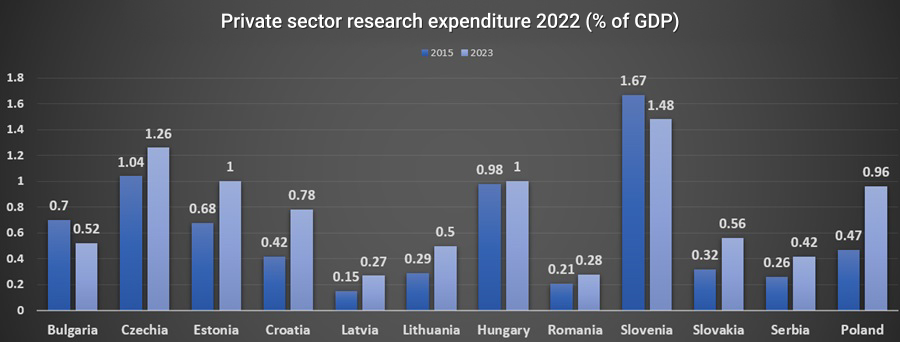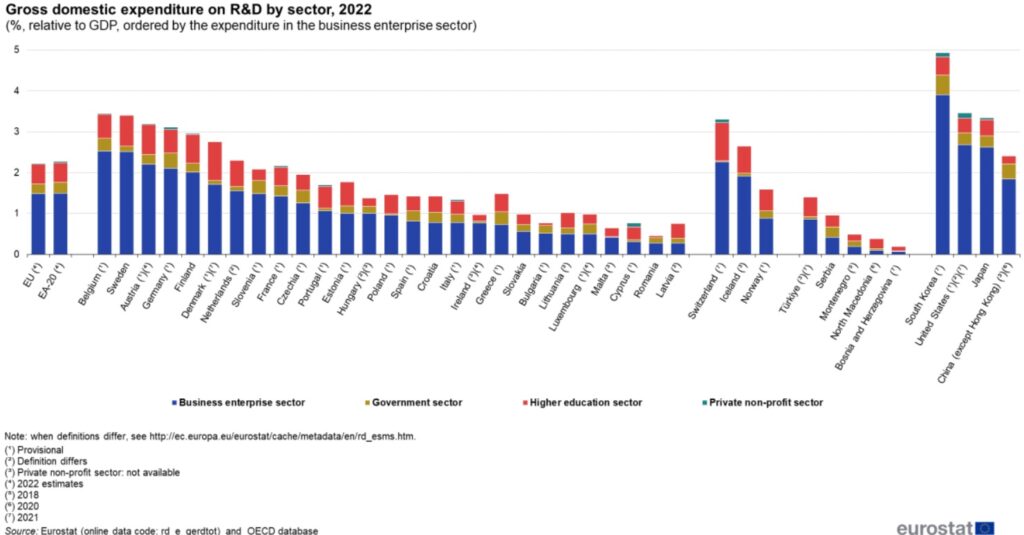While Romania is unable to exceed the threshold of 0.5% of GDP in terms of total expenditure (public and private funds) on Research and Development (R&D), companies in four member states in the region already register contributions exceeding 1% of GDP to this indicator.
The fact that should give concern to governing authorities is that the paltry sums allocated by the state to this sector are NOT consistently supplemented by private companies’ R&D expenditure, as is the case in neighboring countries.
Companies in Poland spent over EUR 6 billion on Research and Development (R&D) in 2022, while those in the Czech Republic, with a population of 10.5 million, nearly EUR 3.5 billion.
The private sector in Romania spent a little over EUR 800 million on R&D.
Given this unfavorable picture of the moment, Romanian government authorities aren’t even setting serious targets anymore, unlike their neighbors, so that, while states in the region will near the EU average (of 2.23% in 2022), Romania will lag behind.
Our country has set its new target at 1% of GDP for the end of this European financial term (2027), having missed the first target term – 2020.
By comparison, the Czech Republic aims to allocate 2.5% of GDP for R&D, from combined public and private funds.
However, without Research and innovation, the added value in economy will remain small: it is not only quantity, but above all the quality of investments that matters.
In absolute terms, Poland is the champion in the region, with EUR 6.285 billion, while Slovenia (with 1.48%) and the Czech Republic (with 1.26%) stand out in terms of GDP share representing private sector expenditure on Research and Development.
In Hungary and Estonia, private expenditure on R&D reached 1% of GDP in 2022, while Poland neared the threshold, with 0.96%.
The EU average of business sector expenditure on Research reached 1.48% in 2022, to which the states’ public expenditure was added.
Only in Latvia (1.88 million inhabitants), the private sector allocates for R&D less compared to Romania, but Research in Latvia receives 0.75% of GDP from combined sources, in comparison with the 0.46% it receives in Romania.
The Czech Republic’s evolution stands out, nearing Ireland’s contribution (EUR 3.48 billion, compared to the latter’s EUR 3.88 billion), despite the much delayed start in the international competition in the field.
Business sector Research expenditure, an indicator for economy’s added value and essential factor for long-term growth
In highly developed countries, companies’ Research expenditure share is much higher than the global and regional average. While EU average was lowered to 1.48% of GDP by the east of the continent, Union performers register percentages closer to those of the most developed states:
- In South Korea, private sector Research expenditure reached 3.90% of GDP
- USA – 2.68%
- Japan – 2.26%
- Belgium – 2.53%
- Sweden – 2.51%
- Austria – 2.20%
- Germany – 2.11%
Moreover, the gap between the EU and its main global competitors comes from the difference of business sector investments in the field, as indicated by all analyses of the European Commission concerning Research, Development and Innovation.
The source of differences in the region
When it comes to foreign investments in R&D, transport infrastructure plays no part, as is the case of industrial production. The essentials consist of facilities granted to players in the field, that it, the position on the list of priorities held by government authorities, legislative predictability and, above all, human resource.
Successive governments in our country have ignored Research and Education, and the increasingly evident effects can be observed in growth and development limitations.
Unlike in Romania, for example, funds allocated for R&D in Poland increased at a steady pace over the past years, consistent with the conceived long-term growth policies. Poland registered an advance of nearly 19% in total allotments, in seven years reaching 1.5% of GDP, in 2022, compared to 1% in 2015. Almost 65% of the total consists of private sector contributions.
A 2022 study by KPMG showed that in Lithuania, Slovakia, Hungary, Poland and Croatia, supplementary deductions reached significant values of up to 300% of total expenses. According to World Bank data, cited by the KPMG study, global key players in terms of RDI expenditures relative to GDP include: Israel (5.44%), USA (3.45%), South Korea (4.81%), Japan (3.26%) and Sweden (3.14%).
Pressing the wound: human resource
The situation is dramatic when it comes to human resources.
In Romania, only 0.39% of the labor force is represented by R&D employees, while the share in the Czech Republic is 1.28%, above the EU average of 1.21%, while Poland registers a share of 0.65%.
In absolute figures, in 2022, Poland, with a population of 37.8 million, had 321,400 persons involved in research and experimental development. Romania registered less than 50,000 employees, of which 10,000 were NOT researchers or technicians, while companies (listing R&D as main or secondary activity) employed less than 15,000 persons.
The big difference comes from downstream, from the pool where these talents are formed, increasingly sought after worldwide. While the share of higher education graduates of the total young population (25 – 34 years old) has exceeded the 40% threshold in Poland over the past years, Romania is nearing 25%.
Considering the available resources, Poland is the home of more than 10,000 innovative businesses, additionally hosting research centers opened by tens of tech giants. In 2021, Google officially launched their cloud center in Warsaw, the first Central and Eastern European facility providing cloud infrastructure for companies in Poland and in neighboring countries.
****












